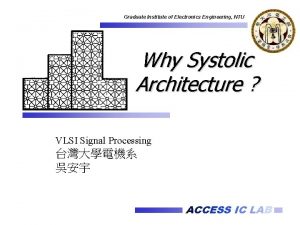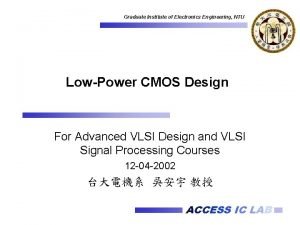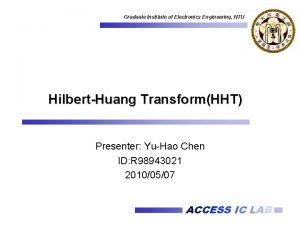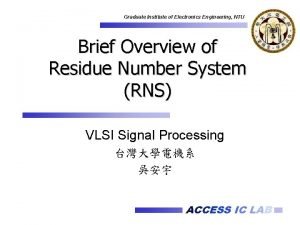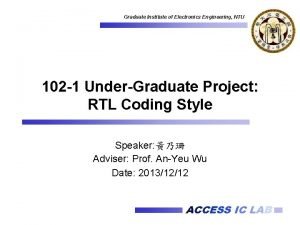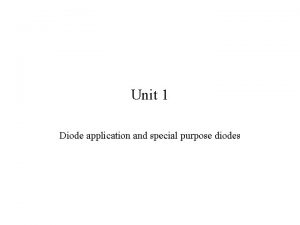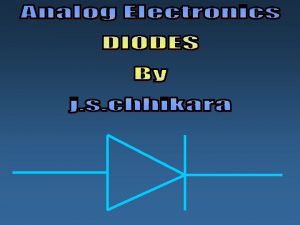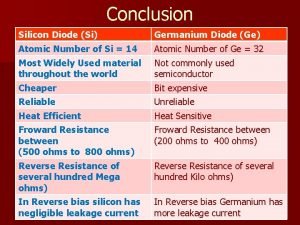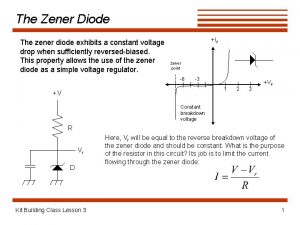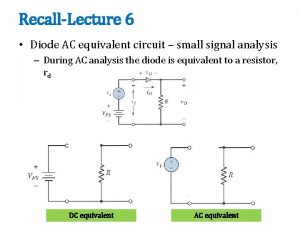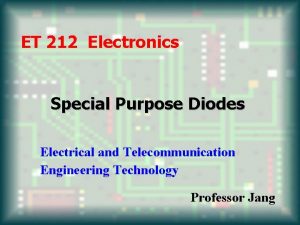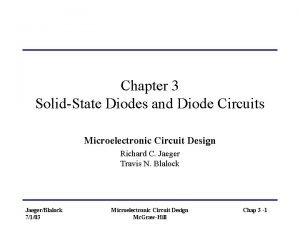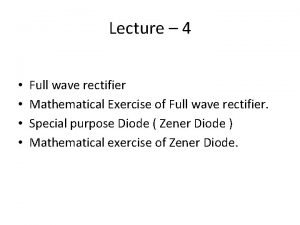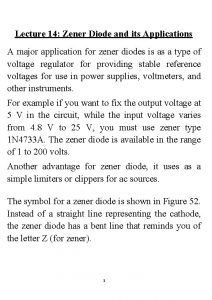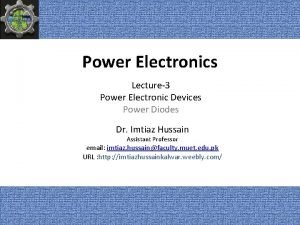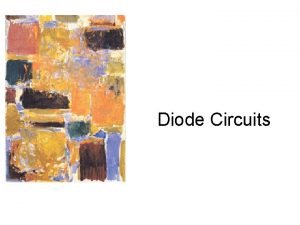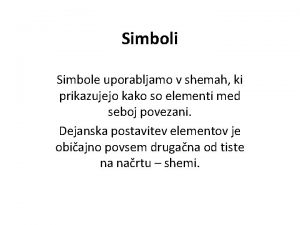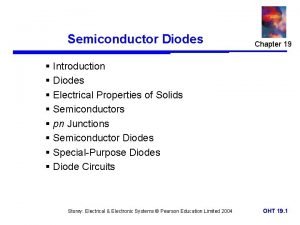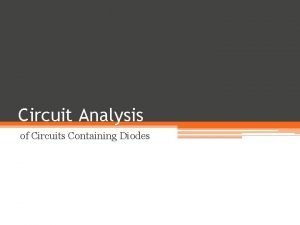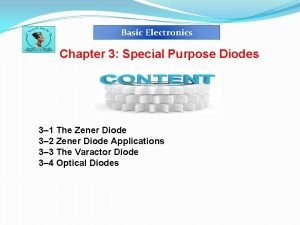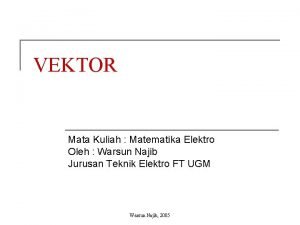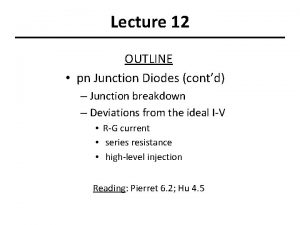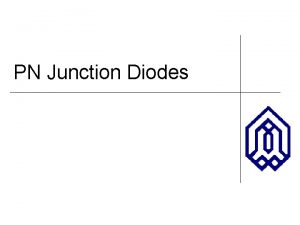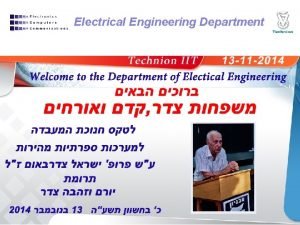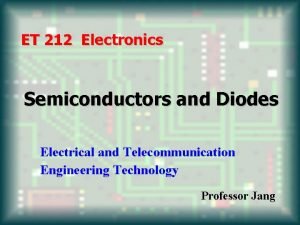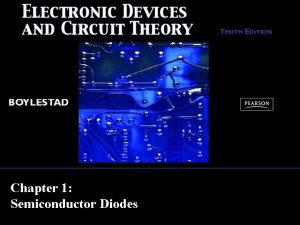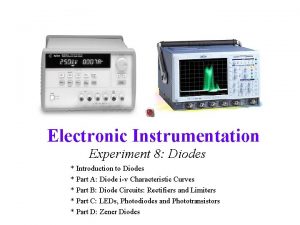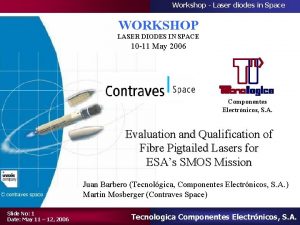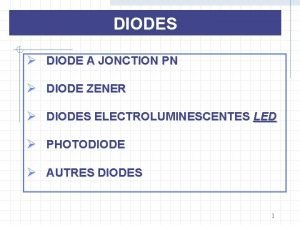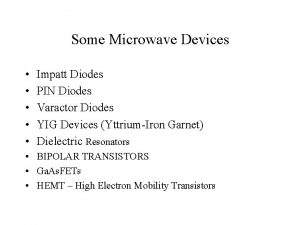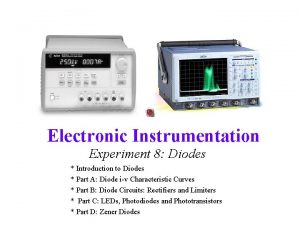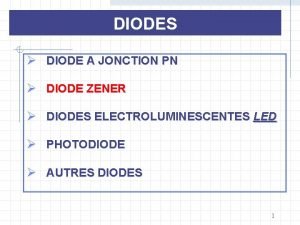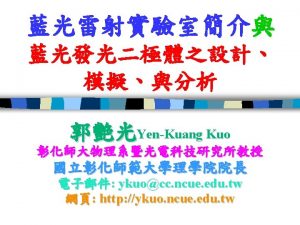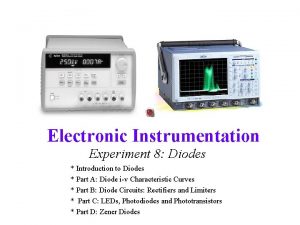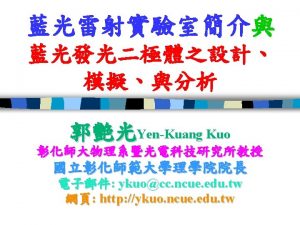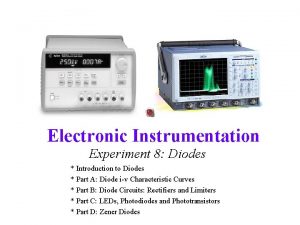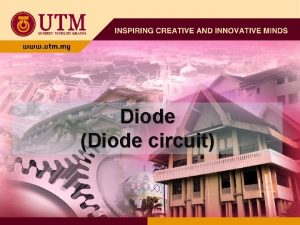PN junction diodes Department of Electrical Electronics Engineering


































- Slides: 34

PN junction diodes Department of Electrical & Electronics Engineering, Amrita School of Engineering

PN Junction Diode • Allows current to flow in one direction but not the other • The anode connects to the ptype material, the cathode to the n-type material of the diode. Department of Electrical & Electronics Engineering, Amrita School of Engineering

Forward Biased Diodes • The component is biased so that the anode is more positive than the cathode. • The diode conducts fully when VF is approximately 0. 7 V (for silicon) or 0. 3 V (for germanium). • The value of IF depends on the circuit voltage and resistance values. Department of Electrical & Electronics Engineering, Amrita School of Engineering

Reverse Biased Diodes • The component is biased so that the cathode is more positive than the anode. • The voltage across the diode is approximately equal to the applied voltage (V ). • The diode current is approximately 0 A (as indicated by the ammeter). Department of Electrical & Electronics Engineering, Amrita School of Engineering

Ideal diode characteristics n When forward biased (closed switch), the diode: n Has no resistance. n Does not limit current. n Has no voltage drop across its terminals. • When reverse biased (open switch), the diode: – Has infinite resistance. – Blocks current. – Drops the applied voltage across its terminals. Department of Electrical & Electronics Engineering, Amrita School of Engineering

Current through Ideal diode I = 10 m. A I = 0 m. A Department of Electrical & Electronics Engineering, Amrita School of Engineering

Characteristics of Junction diode Forward-bias region # Cut-in voltage - below which, minimal current flows - approximately 0. 5 V # Fully conducting region – region where Rdiode is approximately equal zero – between 0. 6 and 0. 8 V Diode current, Department of Electrical & Electronics Engineering, Amrita School of Engineering

Characteristics of Junction diode Reverse-bias region # Saturation currentconstant current in reverse direction i = - Is # Breakdown – when VD << 0 Department of Electrical & Electronics Engineering, Amrita School of Engineering

Exponential Model – most difficult to employ in circuit analysis • due to nonlinear nature • solve for ID in the circuit – VDD = 5 V – R = 1 k. Ohm – ID = 1 m. A @ 0. 7 V • Solution… – graphical method Department of Electrical & Electronics Engineering, Amrita School of Engineering

Graphical Analysis Using Exponential Model • load line and diode characteristic intersect at operating point Department of Electrical & Electronics Engineering, Amrita School of Engineering

Diode Temperature dependence The forward voltage drop decrease by approx. 2 m. V for every 1°C increase in temperature The reverse saturation current Is will double in magnitude for every 10°C increase in temperature Department of Electrical & Electronics Engineering, Amrita School of Engineering

Diode Resistance • DC or Static Resistance RD = VD/ID Department of Electrical & Electronics Engineering, Amrita School of Engineering

Diode Resistance • AC or Dynamic Resistance Department of Electrical & Electronics Engineering, Amrita School of Engineering

Diode Resistance • Determining AC or Dynamic Resistance rd = ηVT ID At room temperature VT = 26 m. V rd = 26 m. V / ID Department of Electrical & Electronics Engineering, Amrita School of Engineering

i-v relationship • ID = Is (e. V /ηV - 1) D T Current I 1 corresponding to diode voltage V 1 I 1 = Is (e. V /ηV ) Current I 2 corresponding to diode voltage V 2 I 2 = Is (e. V /ηV ) 1 T 2 T I 2/I 1 = e. V 2 –V 1/ηVT V 2 –V 1 = ηVT ln(I 2/I 1) V 2 –V 1 = 2. 3ηVT log(I 2/I 1) Department of Electrical & Electronics Engineering, Amrita School of Engineering

Diode Specifications • • Forward voltage Vf Maximum forward current If Reverse saturation current Reverse voltage • Peak Repetitive Reverse Voltage VRRM (or) • Peak Inverse Voltage PIV • Maximum power dissipation • Capacitance levels • Operating temperature range Department of Electrical & Electronics Engineering, Amrita School of Engineering

Diode Specifications • Peak Repetitive Reverse Voltage VRRM n VRRM is the maximum reverse voltage that a diode can withstand. n When VR > VRRM , diode reverse current (IR) increases rapidly as the depletion layer breaks down. • Average Forward Current (IF ) – The maximum allowable value of dc forward current for a diode. • Forward Power Dissipation ( PD(max) ) – The maximum possible power dissipation of the forward-biased diode. Department of Electrical & Electronics Engineering, Amrita School of Engineering

Diode Specification Sheets Department of Electrical & Electronics Engineering, Amrita School of Engineering

Diode Specification Sheets Department of Electrical & Electronics Engineering, Amrita School of Engineering

Types of Diodes Department of Electrical & Electronics Engineering, Amrita School of Engineering

Diode Testing Department of Electrical & Electronics Engineering, Amrita School of Engineering

Diode Testing Department of Electrical & Electronics Engineering, Amrita School of Engineering

Diode Applications Department of Electrical & Electronics Engineering, Amrita School of Engineering

Diode Application Department of Electrical & Electronics Engineering, Amrita School of Engineering

Diode Application Department of Electrical & Electronics Engineering, Amrita School of Engineering

Clippers and Clampers Department of Electrical & Electronics Engineering, Amrita School of Engineering

Diode Clippers § A clipper (or limiter) is a circuit used to eliminate some portion (or portions) of a waveform. ◦ A series clipper is in series with its load. ◦ A shunt clipper is in parallel with its load. Department of Electrical & Electronics Engineering, Amrita School of Engineering

Series Clippers Department of Electrical & Electronics Engineering, Amrita School of Engineering

Series Biased Clippers Department of Electrical & Electronics Engineering, Amrita School of Engineering

Biased Shunt Clippers Department of Electrical & Electronics Engineering, Amrita School of Engineering

Clampers Department of Electrical & Electronics Engineering, Amrita School of Engineering

Clampers Department of Electrical & Electronics Engineering, Amrita School of Engineering

Voltage Doublers • A voltage doubler provides an output that is twice its peak input voltage. Department of Electrical & Electronics Engineering, Amrita School of Engineering

Voltage Doublers Department of Electrical & Electronics Engineering, Amrita School of Engineering
 Conjunction junction what's your function meaning
Conjunction junction what's your function meaning Electrical engineering department
Electrical engineering department Tum
Tum Ucla systems engineering
Ucla systems engineering Explosion proof electrical junction boxes
Explosion proof electrical junction boxes Department of electronics & information technology
Department of electronics & information technology It department odisha
It department odisha Graduate institute of electronics engineering
Graduate institute of electronics engineering Graduate institute of electronics engineering
Graduate institute of electronics engineering Graduate institute of electronics engineering
Graduate institute of electronics engineering Graduate institute of electronics engineering
Graduate institute of electronics engineering Graduate institute of electronics engineering
Graduate institute of electronics engineering Diodes
Diodes State any two special purpose diodes
State any two special purpose diodes What are diodes made of
What are diodes made of Diode conclusion
Diode conclusion Zener diodes exhibit
Zener diodes exhibit Small signal diode model
Small signal diode model What are special purpose diodes
What are special purpose diodes Diode current flow
Diode current flow Full wave rectifier 4 diodes
Full wave rectifier 4 diodes Advantages of zener diode
Advantages of zener diode Diode symbol
Diode symbol Mesh analysis with diodes
Mesh analysis with diodes Luisovi simboli
Luisovi simboli Introduction to diodes
Introduction to diodes Circuit analysis with diodes
Circuit analysis with diodes Special purpose diodes
Special purpose diodes Vector electrical engineering
Vector electrical engineering George washington university electrical engineering
George washington university electrical engineering Tel aviv university electrical engineering
Tel aviv university electrical engineering Northwestern computer science department
Northwestern computer science department Klipsch school of electrical and computer engineering
Klipsch school of electrical and computer engineering Umd ece faculty
Umd ece faculty Electrical estimate and costing
Electrical estimate and costing







